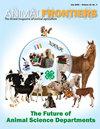基因组选择:动物育种的范式转变
IF 3.2
2区 农林科学
Q1 AGRICULTURE, DAIRY & ANIMAL SCIENCE
引用次数: 315
摘要
•传统的标记辅助选择(MAS)并没有导致DNA信息在动物育种中的广泛使用。主要原因是畜牧生产中感兴趣的性状比预期的要复杂得多:它们是由数千个基因决定的,对表型的影响很小。这些影响通常太小而不具有统计学意义,因此被忽略。•基因组选择(GS)假设所有标记都可能与影响性状的基因有关,并集中于估计它们的影响,而不是测试其重要性。三个技术突破导致了DNA信息在动物育种中的广泛应用:基因组选择技术的发展,大量遗传标记(单核苷酸多态性)的发现;以及高通量技术,以经济有效的方式对动物进行(数十万)个SNPs的基因分型。•在这里,我们回顾了当前的GS方法,包括它们如何处理大量缺失基因型的实际数据。全基因组序列数据的使用是预期的,其优点和缺点进行了描述。描述了GS对奶牛和肉牛、猪和家禽育种的当前和预测的未来影响。最后,对未来的发展方向进行了展望。•预计未来的GS应用将会是:品种内(wbGS),通过保持大量品种内参考种群来获得准确性;或跨品种(abGS),其中准确性来自跨品种参考群体和高密度GS方法,重点关注致病基因组区域。我们认为,未来的GS应用将越来越多地转向abGS。本文章由计算机程序翻译,如有差异,请以英文原文为准。
Genomic selection: A paradigm shift in animal breeding
• Traditional marker-assisted selection (MAS) did not result in a widespread use of DNA information in animal breeding. The main reason was that the traits of interest in livestock production were much more complex than expected: they were determined by thousands of genes with small effects on phenotype. These effects were usually too small to be statistically significant and so were ignored. • Genomic selection (GS) assumes that all markers might be linked to a gene affecting the trait and concentrates on estimating their effect rather than testing its significance. Three technological breakthroughs resulted in the current wide-spread use of DNA information in animal breeding: the development of the genomic selection technology, the discovery of massive numbers of genetic markers (single nucleotide polymorphisms; SNPs), and high-throughput technology to genotype animals for (hundreds of) thousands of SNPs in a cost-effective manner. • Here we review current methods for GS, including how they deal with practical data, where genotypes are missing on a large scale. The use of whole-genome sequence data is anticipated, and its advantages and disadvantages are depicted. Current and predicted future impacts of GS on dairy and beef cattle, pigs, and poultry breeding are described. Finally, future directions for GS are discussed. • It is anticipated that future GS applications will either be: within breed (wbGS), where accuracy is obtained by maintaining huge withinbreed reference populations; or across breed (abGS) where accuracy is obtained from across-breed reference populations and high-density GS methods that focus on causative genomic regions. We argue that future GS applications will increasingly turn toward abGS.
求助全文
通过发布文献求助,成功后即可免费获取论文全文。
去求助
来源期刊

Animal Frontiers
Veterinary-Food Animals
CiteScore
6.50
自引率
5.60%
发文量
74
期刊介绍:
Animal Frontiers is the official journal of the following globally active professional animal science societies:
ASAS, the American Society of Animal Science
CSAS, the Canadian Society of Animal Science
EAAP, the European Federation of Animal Science
AMSA, the American Meat Science Association
These organizations are dedicated to the advancement and dissemination of science-based knowledge concerning animal agriculture. Animal Frontiers provides a novel forum for innovative and timely perspectives that have relevance to understanding the complex dynamics at work through animal agriculture. Animal Frontiers publishes discussion and position papers that present several international perspectives on the status of high-impact, global issues in animal agriculture. Every issue will explore a theme of broad and current interest within animal science and animal agriculture.
 求助内容:
求助内容: 应助结果提醒方式:
应助结果提醒方式:


